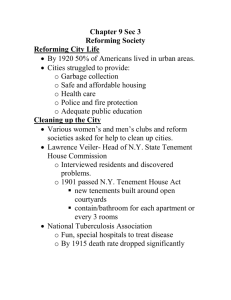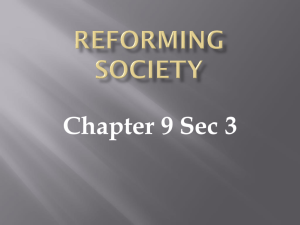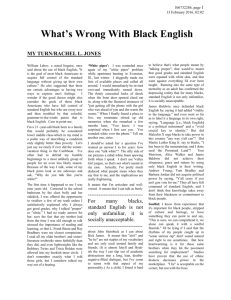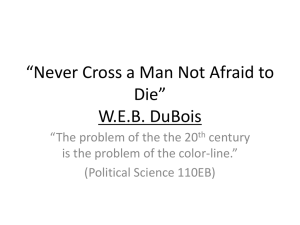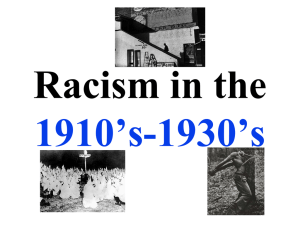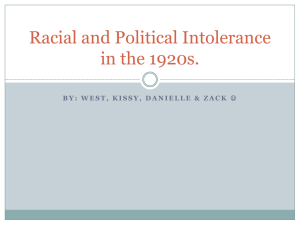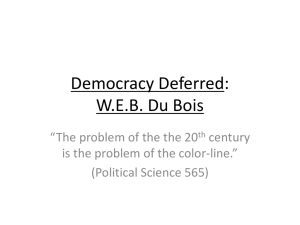Lecture: Urban Pluralism
advertisement
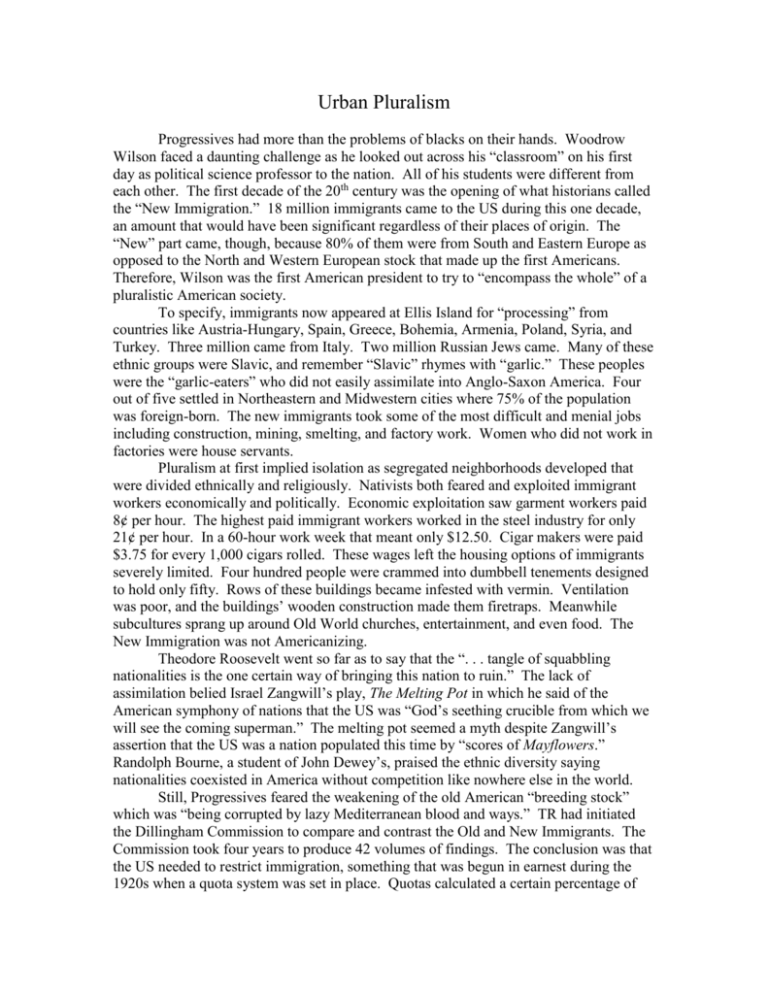
Urban Pluralism Progressives had more than the problems of blacks on their hands. Woodrow Wilson faced a daunting challenge as he looked out across his “classroom” on his first day as political science professor to the nation. All of his students were different from each other. The first decade of the 20th century was the opening of what historians called the “New Immigration.” 18 million immigrants came to the US during this one decade, an amount that would have been significant regardless of their places of origin. The “New” part came, though, because 80% of them were from South and Eastern Europe as opposed to the North and Western European stock that made up the first Americans. Therefore, Wilson was the first American president to try to “encompass the whole” of a pluralistic American society. To specify, immigrants now appeared at Ellis Island for “processing” from countries like Austria-Hungary, Spain, Greece, Bohemia, Armenia, Poland, Syria, and Turkey. Three million came from Italy. Two million Russian Jews came. Many of these ethnic groups were Slavic, and remember “Slavic” rhymes with “garlic.” These peoples were the “garlic-eaters” who did not easily assimilate into Anglo-Saxon America. Four out of five settled in Northeastern and Midwestern cities where 75% of the population was foreign-born. The new immigrants took some of the most difficult and menial jobs including construction, mining, smelting, and factory work. Women who did not work in factories were house servants. Pluralism at first implied isolation as segregated neighborhoods developed that were divided ethnically and religiously. Nativists both feared and exploited immigrant workers economically and politically. Economic exploitation saw garment workers paid 8¢ per hour. The highest paid immigrant workers worked in the steel industry for only 21¢ per hour. In a 60-hour work week that meant only $12.50. Cigar makers were paid $3.75 for every 1,000 cigars rolled. These wages left the housing options of immigrants severely limited. Four hundred people were crammed into dumbbell tenements designed to hold only fifty. Rows of these buildings became infested with vermin. Ventilation was poor, and the buildings’ wooden construction made them firetraps. Meanwhile subcultures sprang up around Old World churches, entertainment, and even food. The New Immigration was not Americanizing. Theodore Roosevelt went so far as to say that the “. . . tangle of squabbling nationalities is the one certain way of bringing this nation to ruin.” The lack of assimilation belied Israel Zangwill’s play, The Melting Pot in which he said of the American symphony of nations that the US was “God’s seething crucible from which we will see the coming superman.” The melting pot seemed a myth despite Zangwill’s assertion that the US was a nation populated this time by “scores of Mayflowers.” Randolph Bourne, a student of John Dewey’s, praised the ethnic diversity saying nationalities coexisted in America without competition like nowhere else in the world. Still, Progressives feared the weakening of the old American “breeding stock” which was “being corrupted by lazy Mediterranean blood and ways.” TR had initiated the Dillingham Commission to compare and contrast the Old and New Immigrants. The Commission took four years to produce 42 volumes of findings. The conclusion was that the US needed to restrict immigration, something that was begun in earnest during the 1920s when a quota system was set in place. Quotas calculated a certain percentage of particular ethnicities’ numbers of immigrants coming in during previous years to be allowed to come in each new year. Unsurprisingly, North and Western Europeans were allotted higher percentages than were Southern and Eastern Europeans. Meanwhile, the only immigrant group that did not want to come to America, blacks, was struggling under a national belief in “scientific” evidence of their inferiority. The Populist Revolt had scared powerful whites in the South because black farmers had belonged to the Southern Alliance of the Grange. That type of organized involvement threatened to break the ability of sharecropping to “keep blacks in their place,” hence the whites continued ongoing efforts to disenfranchise blacks despite the 15th Amendment. On a central moral issue of their day, Progressives were silent. Since they ignored racism against blacks it appeared that they condoned it whether they did or not. Some white politicians were openly racist, and we’ve already seen that Woodrow Wilson liked the film Birth of a Nation. Eighty percent of blacks lived in the South and were confronted with a tradition of racism. Northern racism drove blacks in northern cities into “black neighborhoods,” or ghettos. Sadly, as lynching declined in the South, race riots increased in the North. Social tension spurred widespread racial violence across urban centers from 1906 on. The laissez faire attitudes of government from the 19th century endured in this regard—no further attempts were made by the federal government to aid and elevate the freedmen until the middle of the 20th century. The United States had taken Frederick Douglass’s advice to “. . . let the black man alone.” Two black reformers, however, tried in their own ways to elevate their race. Unfortunately while their approaches could have complemented each other nicely, Booker T. Washington and W. E. B. Du Bois criticized each other. Neither approach was widely successful partly because of this division. Booker T. Washington was born a slave but was so determined to get an education he, like Lincoln, taught himself to read by writing letters in soot on a shovel with a nail. This commitment to education went way beyond elevating himself. He founded Tuskegee Institute for black students in Alabama. Tuskegee was a “Normal and Industrial School.” While you may not believe it considering who your teachers are, normal schools were for the training of teachers, and Washington wanted his race to produce more of them. Industrial schools were like our vocational schools, and Washington wanted blacks to become so skilled at, say, bricklaying or plumbing to be in demand, to become economic necessities to America. He believed that in this way blacks could earn respect and equal treatment and rights. For this moderate approach to civil rights Booker T. Washington was awarded with some respect in the white community. Theodore Roosevelt took the remarkable step of inviting Washington to dine with him at the White House for lunch. Frederick Douglass had visited with Lincoln, but Washington was the first black man to dine with a president of the United States. In an unconsciously condescending gesture, TR said Washington was a “good negro” after the meeting. Washington’s philosophy was best expressed in a speech he gave now known as the “Atlanta Compromise.” Holding up his hand he said, “In all things purely social we can be as separate as the five fingers, and yet one as the hand in all things essential to mutual progress.” Ray Stannard Baker took a bold step as a white Progressive writer in 1908 in publishing Following the Color Line. His book asked the question—Does democracy really include negroes as well as white men? The 1896 Supreme Court decision in Plessy v. Ferguson seemed to indicate the answer was, “No.” The Supreme Court approved of racial segregation of schools as long as the facilities were “separate but equal.” Later debates about the equality of separate educational facilities aside, the separate educational facilities were rarely of equivalent quality. In almost every southern city residents can still point to a building that used to be the black high school, and the building is usually the oldest owned by the school system. Such injustice outraged W. E. B. Du Bois who was himself a Progressive. Rather than being born a slave, Du Bois was a New England graduate of Harvard who became a professor at a university in Atlanta by 1897. As a part of his research in sociology he conducted surveys in Philadelphia as Jane Addams had done in Chicago. This research and his own experiences produced The Souls of Black Folk in 1903. Du Bois dismissed Washington’s moderate approach saying that work and money were less important than immediate equality and the vote. The problems of blacks were the nation’s problems, he said. Furthermore, Du Bois went so far as to suggest that there was a “Talented Tenth” of his race. Ten percent of blacks were smart enough and educated enough that if the whole race were provided the immediate equality he demanded, those elites would turn and help the other 90%. His insistence did not endear him to the white community so ultimately his approach fell short, too. His most lasting contribution was helping to found the National Association for the Advancement of Colored People, the first major civil rights organization in US history. The NAACP is still around today. Unfortunately Du Bois became so frustrated with the slow pace of change that he abandoned America, became a Marxist, and died in Africa just as the Civil Rights Movement had begun in earnest. The aftermath of slavery, Civil War, and Reconstruction may be the most pervasive struggle America’s pluralistic society has had to endure. Having brought the struggle on ourselves, however, American civilization depends on finding the solution to lasting social harmony among differing ethnicities and competing world views. As the New Immigration began arriving on our shores, the complexity of the American equation became considerably more complex.

